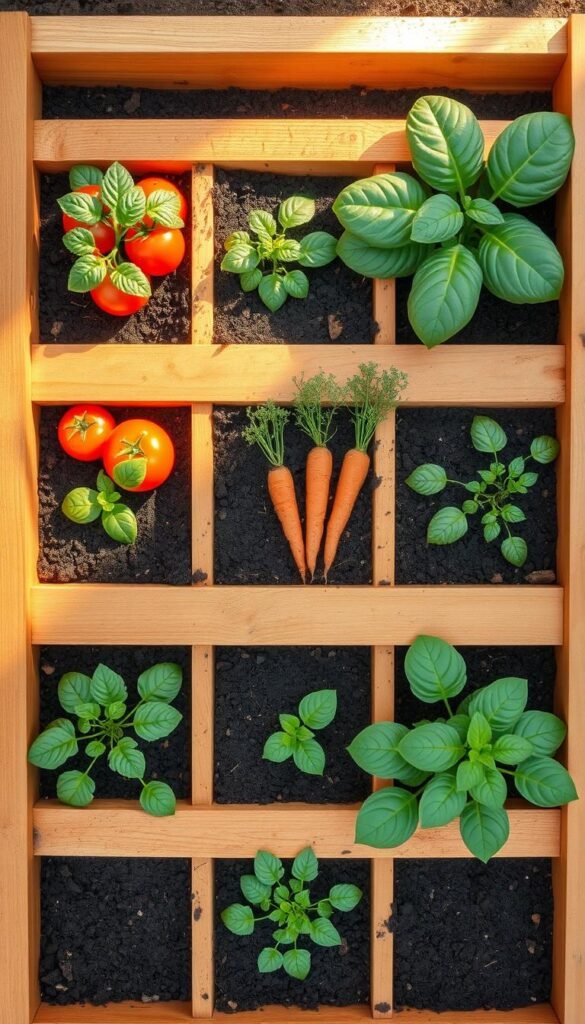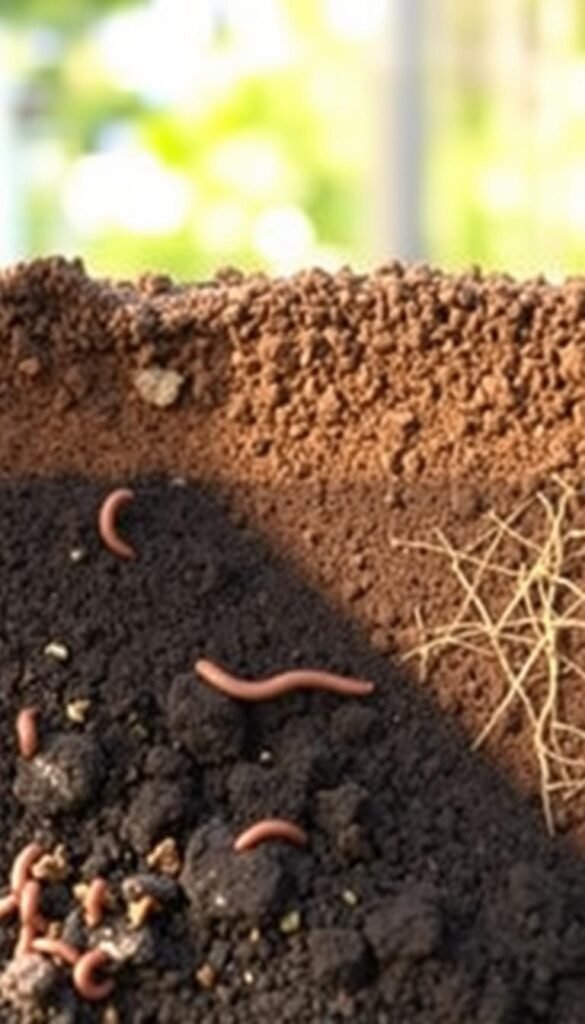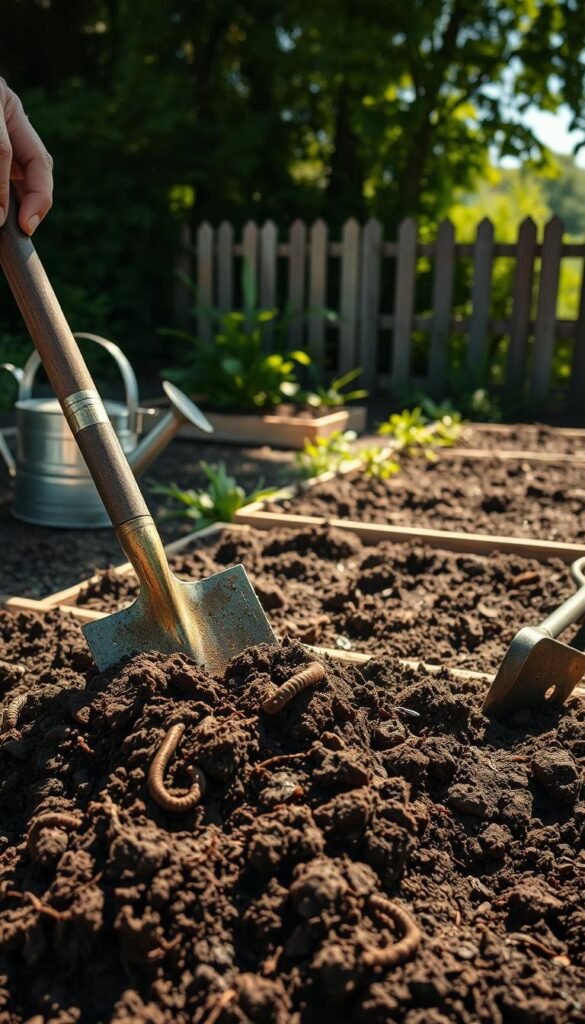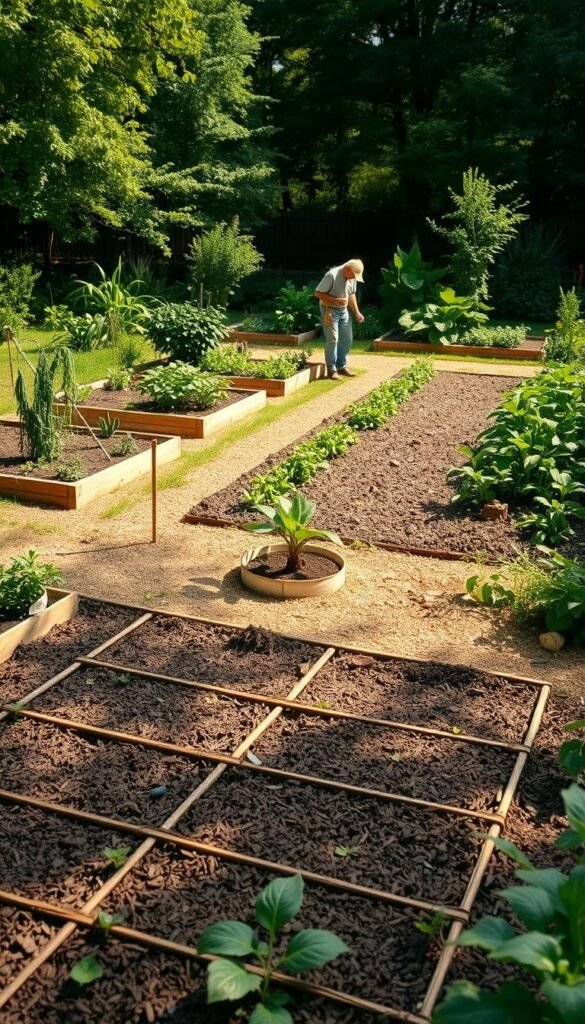When planning your garden, choosing between no-dig and traditional methods can feel overwhelming. Both styles aim to boost plant growth, but they take very different paths to get there. This guide breaks down how each method works within the organized framework of square foot gardening, helping you pick the right fit for your space and goals.
Traditional gardening often involves turning over soil to prepare beds, which can disrupt natural ecosystems. No-dig techniques, on the other hand, layer compost and organic matter directly on top. This protects beneficial microbes and earthworms, creating a healthier foundation for your plants.
We’ll compare how each approach affects your time, effort, and harvests. You’ll learn why soil structure matters, how to use compost effectively, and which method aligns with your gardening style. Real-life examples and expert insights will simplify the decision-making process.
Key Takeaways
- No-dig gardening preserves soil health by avoiding disruptive digging.
- Traditional methods may suit those who prefer hands-on bed preparation.
- Compost acts as a natural fertilizer in both approaches.
- Square foot layouts maximize space regardless of technique.
- Time savings vary based on maintenance and initial setup.
Understanding Square Foot Gardening
Imagine growing a full season’s worth of fresh veggies in a space smaller than your dining table. This is the magic of structured gardening systems that turn tight areas into high-yield food factories. Let’s unpack how this method works and why it’s a game-changer for urban growers and backyard enthusiasts alike.
What Is Square Foot Gardening?
This approach divides your growing bed into a grid of 1-foot squares, typically within a 4×4-foot frame. Each section hosts a specific plant, like 16 radishes or one cabbage per square. The system eliminates guesswork—you’ll know exactly how many vegetables fit in your space without overcrowding.

The Role of Soil and Organic Matter
Healthy soil is the secret sauce here. A mix of compost, peat moss, and vermiculite creates a fluffy, nutrient-rich base. One gardener shared, “My plants doubled in size after switching to this soil recipe—it’s like giving them a five-star buffet!” Regular compost top-ups feed microbes that boost plant growth all year.
By rotating crops every few months, you prevent soil depletion and keep pests guessing. Communities report fewer weeds and easier harvesting in these organized gardens. Plus, labeling each square helps track what’s growing where—no more forgotten carrot rows!
Pros and Cons of the No-Dig Method
Gardeners often debate whether to dig or not to dig—and the answer depends on your soil’s needs. Let’s explore how skipping the shovel impacts your beds, from thriving microbes to stubborn weeds.
Benefits: Preserving Soil Life and Structure
Layering compost and cardboard creates a cozy home for earthworms and fungi. These helpers break down organic matter, releasing nutrients without you lifting a shovel. One grower noted, “My lettuce grew faster in year two as the soil softened naturally—like magic!”

This approach keeps fungal networks intact, which act as underground highways for plant communication. You’ll also trap moisture better, reducing watering during dry weeks. Over time, your beds become self-fertilizing ecosystems.
Challenges: Root Penetration and Maintenance
New no-dig beds can feel like a stiff mattress to plant roots. Carrots and potatoes might struggle to push through compact layers in the first year. One gardener shared, “My beetroots stayed stubby until the soil loosened up by season two.”
Weeds are fewer but sneakier. Seeds buried deeper can sprout years later when exposed to light. Regular mulch top-ups help, though some crops like corn need extra attention to anchor their tall stalks. Despite these hurdles, most find the trade-off worthwhile for healthier food and less backache.
Pros and Cons of Traditional Dig Gardening
While modern techniques grab headlines, traditional soil cultivation still has merits worth exploring. Let’s dig into how turning earth impacts your plants and workload.
Advantages: Enhanced Aeration and Deep Cultivation
Turning soil with a shovel or tiller creates air pockets that roots love. This process lets water penetrate deeper, helping plants access nutrients below the surface. One gardener reported, “My tomatoes thrived after loosening the area—their roots spread twice as wide!”

Over years, regular digging improves drainage in heavy clay soils. Crops like corn and beans develop stronger root systems, boosting overall growth. Farmers cultivating large plots often rely on this method for consistent seed germination.
Disadvantages: Labor Intensity and Weed Exposure
Prepare for sweat equity—tilling a 100-square-foot site can take hours. Each dig session risks bringing dormant weed seeds to the top, creating extra maintenance. Unlike no-dig beds layered with cardboard, traditional plots demand frequent weeding.
| Factor | Traditional Digging | No-Dig |
|---|---|---|
| Labor Required | High | Low |
| Weed Control | Challenging | Easier |
| Soil Structure | Improves Over Time | Instant |
| First-Year Results | Variable | Consistent |
Long-term, excessive tilling can break down soil clumps, reducing moisture retention. One study found undug beds held 30% more water during droughts. Choose this method if you enjoy hands-on work and have energy for seasonal bed prep.
No-Dig vs. Traditional Approaches in Square Foot Gardening: Comparative Insights
Finding your ideal gardening style boils down to balancing effort and results. Let’s explore how these methods stack up in real-world conditions, from first-season setups to multi-year soil health.

Efficiency, Time Investment, and Long-Term Soil Impact
No-dig beds shine in speed. Layering compost and straw takes minutes per square, while traditional plots demand hours of digging. One grower shared, “I prepped my 16-square bed in one afternoon—no sore muscles!”
Over a season, undug soil improves structure naturally. Earthworms work year-round, boosting production by 15-20% in later years. Tilled beds often peak early but require constant amendments.
| Factor | No-Dig | Traditional |
|---|---|---|
| Setup Time | 1-2 hours | 4-6 hours |
| Weekly Care | 20 minutes | 45 minutes |
| Weeds | 5-10% growth | 30-40% growth |
| 3-Year Yields | Consistent | Declines 8% |
Deciding Which Method Fits Your Garden Needs
Choose no-dig if you want low week-to-week upkeep. Cardboard mulch smothers weeds, while straw locks in moisture. For heavy feeders like corn, occasional digging helps roots penetrate compact layers.
Prioritize your available time and long-term goals. Urban gardeners often favor layered beds for hassle-free care, while rural growers may mix methods. Either way, healthy soil remains the key to thriving plants.
Conclusion
Your garden’s success hinges on balancing surface care with underground ecosystems. Both methods discussed offer unique advantages—layered beds protect soil life, while deep cultivation suits certain crops. Think of your lettuce patch: thriving plants need quality compost and smart spacing, whether you disturb the ground or not.
Every garden tells a different story. Clay soils might demand more aeration, while sandy plots benefit from undisturbed organic matter. Bugs become less of a problem when you work with nature’s rhythms, using mulch barriers or companion planting.
Take inspiration from neighbors who’ve solved similar challenges. One urban grower shared, “Switching to straw mulch cut my weeding time in half—that’s one less thing to stress about!” Remember, there’s no single right answer. Your best results come from observing what works in your space and adjusting as needed.
Keep experimenting. Each season teaches something new about soil, plants, and the joy of growing food. With thoughtful choices, you’ll create a resilient garden that feeds both body and soul.






